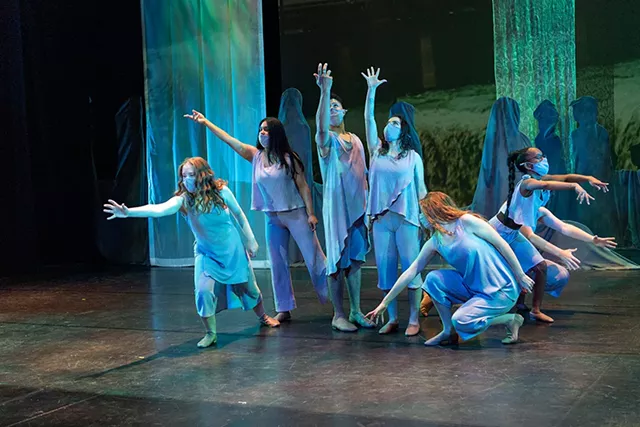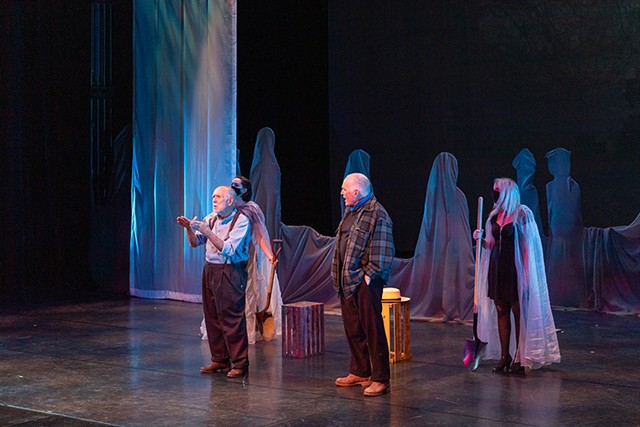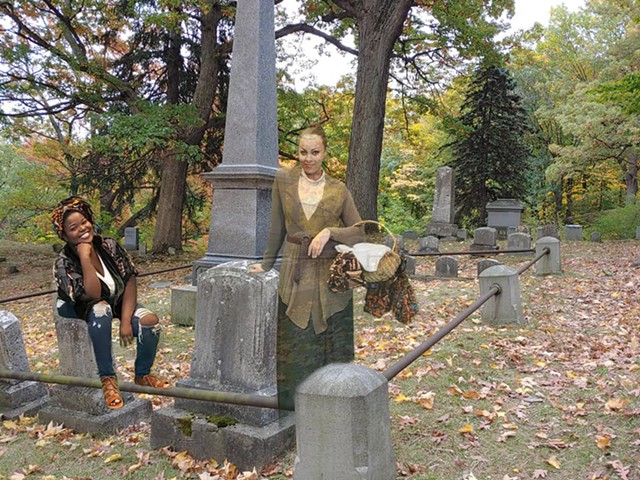“I can imagine what factors seem like even while I am deaf,” Robert Panara wrote in his poem, “On His Deafness.”
I can imagine the strumming of a guitar, I can imagine the rustle of a star.
The text show up at the conclusion of a new production of Edgar Lee Masters’ “Spoon River Anthology,” a century-aged assortment of poems re-envisioned with personal computer technology, and awarded new that means by the raucous and complicated year of 2020. “That was set at the conclusion there,” Dr. Luane Davis Haggerty states of Panara’s poem, “with the hope that persons would see that the topic is that we are all stardust, we are all from the exact, we are all the exact.
“I never know, is that a TED Talk point?”
Stardust. It’s basically a Walt Whitman point.
All two and a 50 percent hours of the ambitious production by Rochester Institute of Technology’s Nationwide Complex Institute for the Deaf is out there on YouTube. Considering that becoming posted previous thirty day period, it has had a lot more than 2,000 sights of its 70 limited vignettes, a mashup of hearing and speaking actors in present-day clothes paired with indication-language interpreters in 1900s-era costumes. Other century-spanning photos are sprinkled all over the display in just one scene, an interpreter beverages from a dainty porcelain tea cup as her speaking companion holds a chrome cocktail shaker.
“That was the 2020 standpoint,” Haggerty states of the shaker. “The 1918 standpoint, we really do not know specifically what was in her teacup, now do we? In the 2020 edition, she was straight-out having a cocktail.”
From that shaker comes a blend of record and present-working day. With COVID-19 now roaring throughout the earth, there’s a new urgency to a perform established in a graveyard with a bunch of lifeless persons delivering their have epitaphs. In Spoon River, almost never does anybody only die in their slumber. And there’s no denying that the lifeless bring a genuine feeling of social distancing to the phase.
“We chose ‘Spoon River’ since of COVID, and then recognizing these are all epitaphs,” Haggerty states. “All of these persons, as you place out, have died diverse odd deaths, some of them from health issues. 1915 to 1918, when Edgar Masters wrote the authentic, was the Spanish flu epidemic, so they are dealing with the exact point that we are now. Which is why I needed a 2020 just take on it. Even if they are speaking in a language that is a minor a lot more flowery than what we obviously use now.
“But to bring that household, that one hundred-many years-apart experience, I didn’t believe all of the voices need to be speaking from the earlier. I needed some of the voices to be speaking from ideal now.”
This production came about as a mix of creativity and requirement. Haggerty, a principal lecturer at NTID’s Section for Carrying out Arts, was all established to make Lin-Manuel Miranda’s “In the Heights” the school’s fall production. But the coronavirus pandemic altered the prepare “In the Heights” is a musical that just would not come off with actual physical distancing.
Now what?
Panara was a male in advance of his time. It was he who first prompt to Haggerty that “Spoon River Anthology” may be a good fit for NTID. But that was in 1998. And even while it still gets aired out to this working day — the KeyBank Rochester Fringe Festival presented it on Gibbs Street in 2014 — the assortment of free-variety poems comes with not only stardust, but a century of dust.
The updating of “Spoon River Anthology” consists of Haggerty introducing the poem by NTID co-founder Panara, who handed absent four many years in the past. And there are dances choreographed by RIT dance instructor Thomas Warfield, and authentic songs by Susan Murphy, such as a topic music. And most significantly, somewhat than positioning the interpreter off to just one aspect, as we see at Gov. Andrew Cuomo’s COVID-19 briefings, here the interpreter is typically front and heart.
“There has to be a reason, it just cannot just be access, from my place of see,” Haggerty states. “For it to be creative, an creative alternative. Not just, ‘Oh good, glance, the interpreter is in the picture.’ I want the interpreter to be performing, too.
“Sharing a purpose for an actor is not constantly effortless, since you have egos associated. But it basically finishes up becoming a seriously excellent resource for cross-cultural interaction, understanding, all that good things.”
In “Spoon River Anthology,” Haggerty observed an opportunity for social commentary. A little something a minor heavier than the brief flash of a cocktail shaker. So weaving their way through Masters’ monologues from past the grave are a 50 percent-dozen new poems and spoken-term parts, composed by the performers them selves, touching on challenges of 2020. A gay male telling his tale of contracting COVID-19. And Black Life Matter. Haggerty wrote the phase in which a white lady defends the do the job of Black Life Matter protesters it is identified as “The Karen Who Died Caring.”
A single of the fascinating elements of this edition of “Spoon River Anthology” is the technology that pulls it collectively. Haggerty had at first prepared to present the perform in front of a stay audience. But as the coronavirus pandemic’s hold on the arts tightened, she decided the display would have to be assembled out of video clip clips. This seriously opened up the casting of the display. “Spoon River Anthology” consists of not only RIT learners, but also alumni from Hawaii to Broadway. There are a lot more than 150 of them. They recorded their components on phones, cameras and computers. So even while the 70 monologues each attribute two persons — the actor and the signing interpreter — in 50 percent of people scenes, the two weren’t even recording in the exact home.
“It was each piece of technology we could get our sweaty minor hands on, it was insane,” Haggerty states. “Digital magic.”
And going the craziest was Dan Roach, a freelance projection and digital magician who’s labored with the place colleges as properly as Geva Theatre Center and Blackfriars Theatre. Roach’s career was to assemble the parts into a complete. The technology for this is identified as green screening. The video clip is shot in opposition to a green backdrop — some of the actors only employed green plastic tablecloths — making it possible for personal computer computer software to drop in the different elements, such as a qualifications.
People backgrounds? Keen Rochester observers will recognize Mt. Hope Cemetery, lilacs at Highland Park, aged postcards depicting Rochester city scenes, even a community goat farm. Roach also took pictures of several wooden-encrusted rooms in Rochester properties and workplaces, to give the inside pictures that 1918 sense. If an actor was sitting down when performing a reading through, Roach had to sneak a chair into the scene, lest the character be remaining floating uncomfortably in the air.
So there you have “Spoon River Anthology,” established in the fictional town of Spoon River, Illinois. In RIT’s edition, “Spoon River and Rochester are very considerably the exact put,” Haggerty states.
Like Panara, Masters may perhaps have been in advance of his time. The line “Sex is the curse of lifestyle, it ruins everything” is not a 2020 creation, it is in the authentic. But when Bugsy Calhoun, a Black actor from New York Town, tells us that “systemic racism killed a lot more of my persons than COVID at any time will,” that is the 2020 standpoint — the voices speaking from the “right now” that Haggerty needed.
“We maintain expressing we’re in unparalleled moments, and it is not legitimate: People had been going through the exact point a hundred many years in the past,” she states.
“We are all so human. That, I believe, is a tangible connection in this time of division and fear. That there’s one thing reassuring about the fact that this has transpired in advance of and we have made it all through collectively. And to have that previous information just be, we are diverse. There is racism, we can say none of this things has been fixed yet. But we are all made of stardust, so we have the opportunity of all coming back collectively.”
Stardust. There’s Whitman once again.
And back to Masters. “There are 244 of these prose poem epitaphs that he wrote in 1915, and became really popular,” Haggerty states. “Because, as you study through them, you start off to see a tapestry of an overall community. You start off to see how particular person lives basically do affect other lives that should not even be in connection. And yet, everyone is connected. Which is how the community gets made.”
Jeff Spevak is WXXI’s arts and lifestyle editor and reporter. He can be attained at [email protected].
This tale was manufactured by WXXI’s Inclusion Desk, concentrating on disabilities and inclusion.









More Stories
Martial Art Styles – Benefits for Women
Anime – Five Different Types and Why You Will Enjoy Them
Eclectic Decor, Artistic Elements